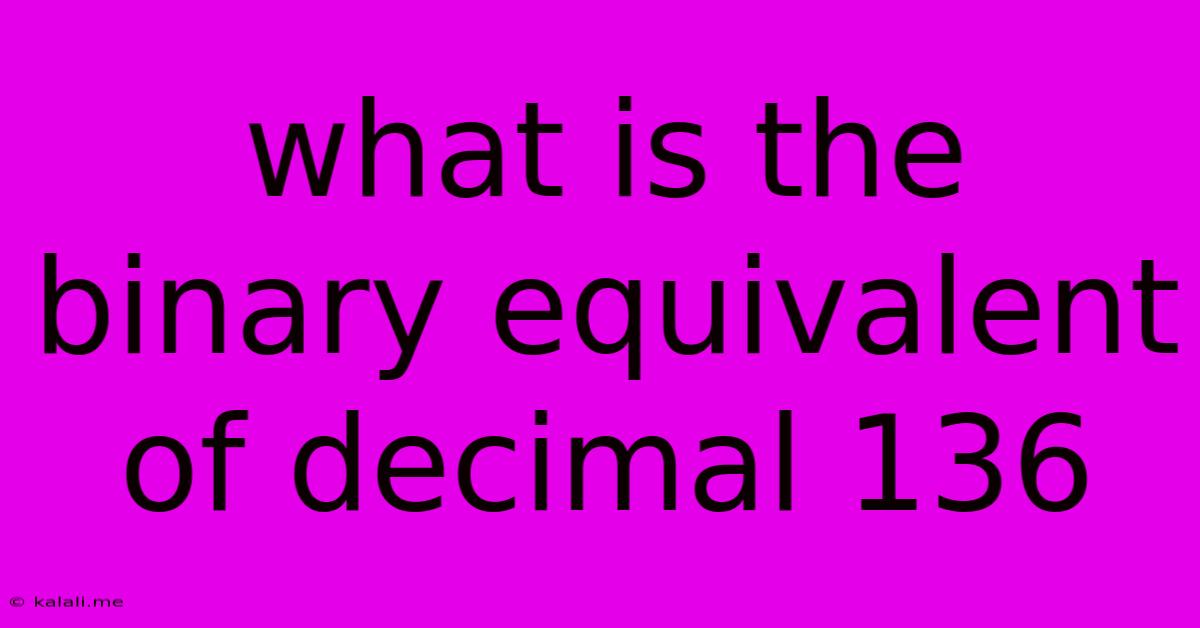What Is The Binary Equivalent Of Decimal 136
Kalali
Jun 12, 2025 · 3 min read

Table of Contents
What is the Binary Equivalent of Decimal 136? A Comprehensive Guide
Meta Description: Learn how to convert decimal numbers to binary. This guide provides a step-by-step explanation of converting decimal 136 to its binary equivalent, along with helpful tips and tricks for similar conversions.
Converting decimal numbers to their binary counterparts is a fundamental concept in computer science and digital electronics. Understanding this process is crucial for anyone working with digital systems or programming. This article will guide you through the conversion of the decimal number 136 into its binary equivalent. We'll explore the methods involved, ensuring you grasp the underlying principles.
Understanding Decimal and Binary Number Systems
Before diving into the conversion, let's briefly review the two number systems:
-
Decimal (Base-10): This is the number system we use daily. It uses ten digits (0-9) and each position represents a power of 10. For example, the number 136 is represented as (1 x 100) + (3 x 10) + (6 x 1).
-
Binary (Base-2): This system uses only two digits: 0 and 1. Each position represents a power of 2. For instance, the binary number 1011 is equivalent to (1 x 8) + (0 x 4) + (1 x 2) + (1 x 1) = 11 in decimal.
Methods for Decimal to Binary Conversion
There are several ways to convert a decimal number to its binary equivalent. We'll focus on two common and straightforward methods:
Method 1: Repeated Division by 2
This method involves repeatedly dividing the decimal number by 2 and recording the remainders. The binary equivalent is formed by reading the remainders in reverse order.
Let's convert 136 to binary using this method:
- 136 ÷ 2 = 68 remainder 0
- 68 ÷ 2 = 34 remainder 0
- 34 ÷ 2 = 17 remainder 0
- 17 ÷ 2 = 8 remainder 1
- 8 ÷ 2 = 4 remainder 0
- 4 ÷ 2 = 2 remainder 0
- 2 ÷ 2 = 1 remainder 0
- 1 ÷ 2 = 0 remainder 1
Reading the remainders from bottom to top, we get the binary equivalent: 10001000
Method 2: Using Powers of 2
This method involves finding the largest power of 2 that is less than or equal to the decimal number. We then subtract this power of 2 and repeat the process until we reach 0. The binary representation is determined by the powers of 2 used.
Let's convert 136 to binary using this method:
- The largest power of 2 less than or equal to 136 is 128 (2<sup>7</sup>).
- 136 - 128 = 8
- The largest power of 2 less than or equal to 8 is 8 (2<sup>3</sup>).
- 8 - 8 = 0
This gives us 2<sup>7</sup> + 2<sup>3</sup> = 128 + 8 = 136. Therefore, the binary representation is 10001000, where the '1's represent the powers of 2 that were used (2<sup>7</sup> and 2<sup>3</sup>).
Verification and Conclusion
Both methods yield the same result: 10001000 is the binary equivalent of decimal 136. You can verify this by converting the binary number back to decimal using the method described earlier. Understanding these conversion techniques is essential for anyone working with computers, programming, or digital systems. Practice these methods with different decimal numbers to solidify your understanding of binary representation. Remember, mastering binary is a foundational skill for many advanced computing concepts.
Latest Posts
Latest Posts
-
Jelly Like Substance In The Cell
Jun 13, 2025
-
What Is 50 Percent Of 50
Jun 13, 2025
-
What Is The Antonym Of Artificial
Jun 13, 2025
-
The Hormone That Stimulates Milk Synthesis Is
Jun 13, 2025
-
How Many Valence Electrons Does Rubidium Have
Jun 13, 2025
Related Post
Thank you for visiting our website which covers about What Is The Binary Equivalent Of Decimal 136 . We hope the information provided has been useful to you. Feel free to contact us if you have any questions or need further assistance. See you next time and don't miss to bookmark.